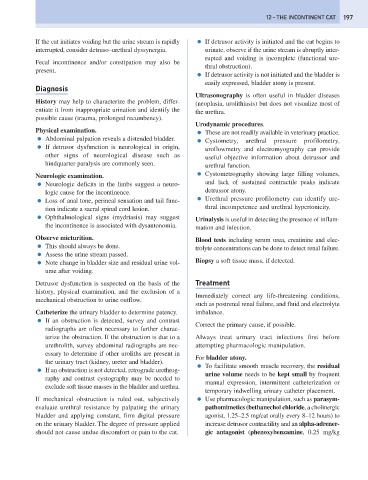Page 205 - Problem-Based Feline Medicine
P. 205
12 – THE INCONTINENT CAT 197
If the cat initiates voiding but the urine stream is rapidly ● If detrusor activity is initiated and the cat begins to
interrupted, consider detruso–urethral dyssynergia. urinate, observe if the urine stream is abruptly inter-
rupted and voiding is incomplete (functional ure-
Fecal incontinence and/or constipation may also be
thral obstruction).
present.
● If detrusor activity is not initiated and the bladder is
easily expressed, bladder atony is present.
Diagnosis
Ultrasonography is often useful in bladder diseases
History may help to characterize the problem, differ- (neoplasia, urolithiasis) but does not visualize most of
entiate it from inappropriate urination and identify the the urethra.
possible cause (trauma, prolonged recumbency).
Urodynamic procedures.
Physical examination. ● These are not readily available in veterinary practice.
● Abdominal palpation reveals a distended bladder. ● Cystometry, urethral pressure profilometry,
● If detrusor dysfunction is neurological in origin, uroflowmetry and electromyography can provide
other signs of neurological disease such as useful objective information about detrussor and
hindquarter paralysis are commonly seen. urethral function.
Neurologic examination. ● Cystometrography showing large filling volumes,
● Neurologic deficits in the limbs suggest a neuro- and lack of sustained contractile peaks indicate
logic cause for the incontinence. detrussor atony.
● Loss of anal tone, perineal sensation and tail func- ● Urethral pressure profilometry can identify ure-
tion indicate a sacral spinal cord lesion. thral incompetence and urethral hypertonicity.
● Ophthalmological signs (mydriasis) may suggest Urinalysis is useful in detecting the presence of inflam-
the incontinence is associated with dysautonomia. mation and infection.
Observe micturition. Blood tests including serum urea, creatinine and elec-
● This should always be done. trolyte concentrations can be done to detect renal failure.
● Assess the urine stream passed.
● Note change in bladder size and residual urine vol- Biopsy a soft tissue mass, if detected.
ume after voiding.
Detrusor dysfunction is suspected on the basis of the Treatment
history, physical examination, and the exclusion of a
Immediately correct any life-threatening conditions,
mechanical obstruction to urine outflow.
such as postrenal renal failure, and fluid and electrolyte
Catheterize the urinary bladder to determine patency. imbalance.
● If an obstruction is detected, survey and contrast
Correct the primary cause, if possible.
radiographs are often necessary to further charac-
terize the obstruction. If the obstruction is due to a Always treat urinary tract infections first before
urethrolith, survey abdominal radiographs are nec- attempting pharmacologic manipulation.
essary to determine if other uroliths are present in
For bladder atony.
the urinary tract (kidney, ureter and bladder).
● To facilitate smooth muscle recovery, the residual
● If an obstruction is not detected, retrograde urethrog-
urine volume needs to be kept small by frequent
raphy and contrast cystography may be needed to
manual expression, intermittent catheterization or
exclude soft tissue masses in the bladder and urethra.
temporary indwelling urinary catheter placement.
If mechanical obstruction is ruled out, subjectively ● Use pharmacologic manipulation, such as parasym-
evaluate urethral resistance by palpating the urinary pathomimetics (bethanechol chloride, a cholinergic
bladder and applying constant, firm digital pressure agonist, 1.25–2.5 mg/cat orally every 8–12 hours) to
on the urinary bladder. The degree of pressure applied increase detrusor contractility and an alpha-adrener-
should not cause undue discomfort or pain to the cat. gic antagonist (phenoxybenzamine, 0.25 mg/kg

